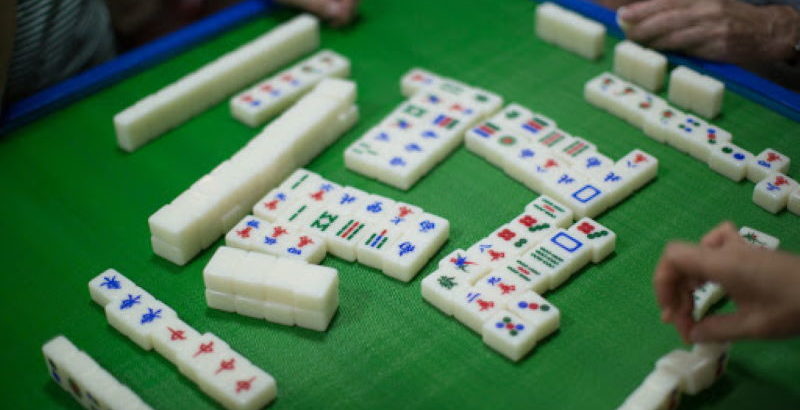Learn How to Play Mahjong With This Beginners Guide!
Mahjong is a social game of skill, cunning strategy and to keep things interesting, a bit of luck. To get an understanding of the game, here are the basic rules of how to play mahjong. This is a description on the most common variation of mahjong play.
The Mahjong Board
The game of mahjong is played by four players at a square table taking the positions of east, south, west, north. The players go through a ritual of using 144 mahjong tiles to stack a side of the “wall” two tiles high in front of each player. The game commences with each player having thirteen tiles taken from the wall of tiles. The player sitting on the eastern seat starts off with the “button” and draws another tile from the wall. This makes the amount of tiles in his hand fourteen. The object of the game is to have a winning hand that is composed of 4 sets of three tiles and a pair of tiles of the same suit. The 4 sets can be a combination of three of a kind or a series of three in the same suit. In other words a winning hand can be described as thus: 4 x 3 + 2 = 14.
The Mahjong Tiles
The player who draws the tile can decide to keep it but must sacrifice another tile in his hand to throw away in the “courtyard” facing up on the table. Or, the player could have drawn the winning tile and won outright. Remember that a player must have thirteen tiles in his hand but win with fourteen.
After the tile has been discarded in the courtyard, any of the three other players can pick this tile up to make a “pung” or 3 of a kind. However, he must reveal this set in front of other players with the tiles facing up before him.
Mahjong Pung and Chow
However, if no player can make a “pung” then the play continues to the person to the right of the player who last discarded a tile. If the tile helps his hand, he has the choice to pick up the tile to make a series of 3 in the same suit otherwise known as a “chow”. As well, he must reveal his intention to do so by putting his set of three tiles facing up for others to see. It is important to note that only a player sitting on the right of the person who just discarded the tile has the right to make a “chow”.
Either way, if a person inherits a tile through a pung or a chow, he must discard another tile to keep the hand at thirteen unless it was the tile to complete a winning hand. The play always continues to the right of the person who just discarded a last tile.
If no pung or chow can be made, then tiles are drawn from the wall. The hand ends either when someone has a winning hand or the number of tiles to draw from the wall run out.
Skill and Luck
As you can see, there’s an element of luck involved with drawing tiles for a good hand. However, with the discarding of tiles into the courtyard, there is also control of what your opponents can pick up from you to build their hand. A careful strategist can determine what tiles their opponents need by the pungs and chows revealed and what a person does NOT discard into the courtyard.
There are many other strategic elements in the game of mahjong. If the game intrigues you, there’s no better way to learn than to pick up a mahjong set and gather a few friends to discover the game for yourself.
A Comprehensive Beginner’s Guide
Mahjong, a popular and intriguing tile-based game, has captured the hearts of players around the world. Originating in China, Mahjong has spread globally, with numerous regional variations emerging over time. This article aims to provide a comprehensive beginner’s guide to learning how to play this fascinating game. We will cover the basics of Mahjong, its rules, and strategies to help you get started on your Mahjong journey.
The Basics of Mahjong
Mahjong is typically played with four players, although some variations accommodate different numbers of participants. The game uses a set of 144 tiles, which are divided into three main categories: suits, honors, and bonus tiles.
- Suits: The suits consist of three types: bamboos (or bams), characters (or craks), and dots (or circles). Each suit has nine tiles, numbered from one to nine, with four identical tiles of each number.
- Honors: The honors are comprised of two types: winds (east, south, west, and north) and dragons (red, green, and white). Each honor tile has four identical tiles.
- Bonus Tiles: These include flower and season tiles. Each flower and season tile is unique, and there are four of each type.
Objective
The primary objective in Mahjong is to be the first player to form a complete hand, known as a “Mahjong.” This hand usually consists of 14 tiles that form four sets of three tiles each (melds) and a pair. Melds can be “pongs” (three identical tiles), “chows” (a sequence of three consecutive tiles in the same suit), or “kongs” (four identical tiles). The pair consists of two identical tiles.
Gameplay
- Setup: The tiles are shuffled, and each player takes turns building a wall of tiles in front of them. The walls are then pushed together to form a square.
- Deal: The dealer (also called East) is chosen randomly or through a roll of dice. The dealer starts by taking four tiles at a time from the wall, moving counter-clockwise. Each player gets 13 tiles, except for the dealer, who gets 14.
- Play: The game begins with the dealer discarding a tile face-up in the center of the table. Players then take turns drawing a tile from the wall and discarding a tile of their choice. The goal is to improve one’s hand by drawing and discarding tiles until a complete Mahjong hand is formed.
- Claims: If a discarded tile completes a meld for a player, they can claim that tile by announcing “pong,” “chow,” or “kong,” depending on the type of meld being formed. If a player claims a tile, they must reveal the completed meld and discard a tile of their own.
- Winning: The game continues until a player forms a complete Mahjong hand and declares “Mahjong.” The winning player reveals their hand, and points are calculated based on the complexity of the hand and any pre-established scoring rules.
- Rounds: Mahjong is typically played in rounds, with the role of the dealer rotating counter-clockwise. The game continues until a predetermined number of rounds have been played, or a specific point threshold has been reached.
Learning to play Mahjong can be a rewarding and enjoyable experience. This beginner’s guide provides an overview of the basics, rules, and strategies of the game. As you continue to play and gain experience, your understanding of the intricacies and strategies of Mahjong will deepen. So, gather some friends, set up the tiles, and immerse yourself in the captivating world of Mahjong.

